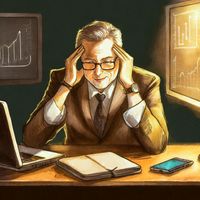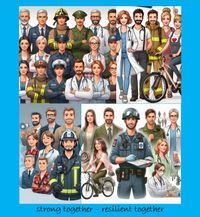Have you thought about it?
New game - new stakes
The political world stage continues to turn relentlessly, and European states may be forced in the future to significantly strengthen their own capacities and resources for crisis management and pandemic preparedness. There might be difficult and very turbulent times ahead, but with joint effort, solidarity, and creative approaches, it could be possible for us to mitigate potential negative impacts while also finding new ways forward. The COVID-19 pandemic has already shown us that crises are becoming increasingly complex and require enormous cross-border cooperation. We must and should not only strengthen our own capacities for pandemic control and combatting, but also utilize valuable resources within our own population that are often still lying dormant.
We need to improve in many areas, not just in catching up structurally with our digitalization efforts. Looking at the Digital Economy and Society Index (DESI) of the EU Commission, Germany ranks only 13th out of 27 EU countries. In the integration of digital technologies in companies, we are even ranked only 18th. Certainly, the now very high electricity prices in Germany also play a role in some companies preferring to relocate abroad if they want to extensively implement AI. We must and should invest significantly more in AI (including in the context of our disaster management) and massively expand the AI infrastructure. Not only universities, schools, and companies need to be made much more fit for AI, but disaster management also requires a comprehensive AI portfolio to be able to truly meet all future challenges (pandemics, Long COVID, ME/CFS, ...) successfully.
It doesn't really help us if we discuss the impending risks daily and have been doing so for years, constantly analyzing and sinking into pessimism. We need to finally take action and do so quickly. Have you taken a look at the new PwC study on global artificial intelligence yet? No, then you should definitely do so ... AI could contribute up to $15.7 trillion to the global economy by 2030, more than the current economic output of India and China combined. (2) Look at the economic gains (GDP increase) through AI in China and North America by 2030. These numbers should make us dizzy, but they should also make us take off our hats in admiration at what these countries are wisely and future-oriented investing in AI.
Chapeau! To take off one's hat! 脱帽 (tuō mào)!
The enormous societal division and the challenges posed by Long COVID, ME/CFS and the increase in neurological diseases require joint efforts and a comprehensive strategy to strengthen resilience. Education, awareness, community spirit, mental health, and practical preparedness are crucial areas where individual and collective actions urgently need to be taken to create a more resilient and stable society. It is important that both the population and political institutions and companies take these challenges seriously and work together to develop solutions, which also includes intensive investment in AI and AR. I, too, have many ideas in the context of disaster management and preparedness, especially for vulnerable target groups (Long COVID, ME/CFS and MCS).
Disaster management structures often focus on proven and traditional methods, which can result in new approaches and groups being overlooked, and valuable resources, true potential, and know-how within the population being left untapped. Disaster management traditionally focuses on larger and established aid organizations and structures, i.e., all emergency services. It is often dominated by established organizations and professional responders, but shouldn't we finally start integrating more innovative approaches? Of course, it is always difficult to break up traditional administrative structures, but we can only overcome all the enormous challenges as a whole society.
The inclusion of new groups in official disaster plans can be:
- certainly hindered by bureaucratic hurdles and lengthy approval processes
- unclear responsibilities and accountabilities could hinder cooperation between different groups and authorities
- the inclusion of new groups requires additional resources for training, equipment, and coordination, posing financial and logistical challenges
- there could be a lack of funding opportunities to provide the necessary investments for the integration of new groups
- coordinating and integrating various new groups requires additional planning and communication, which can be time-consuming and complex
- without prior pilot projects and successful examples, it can be difficult to demonstrate the effectiveness and feasibility of integrating new groups
- without established networks and partnerships, the integration of new groups could be more challenging
- there could be a lack of effective communication and cooperation between various stakeholders to successfully integrate new groups
These are probably all arguments that might immediately come to the mind of one or another disaster manager.
BUT, by doing so, we would stifle every valuable approach and new pathways that we must also pursue to be properly equipped. We need to explore and appropriately utilize new terrain in the NOW and HERE.
Where do I personally see enormous potential that could be "tapped"?
1. Integration of bicycle and e-scooter couriers in disaster management
2. Maker Community: Establishing workshops and courses where the population can learn how to create simple but effective emergency solutions and devices, such as portable chargers or water filtration systems. Creating "Innovation Hubs" in cities and communities that serve as contacts for technological support and creative problem-solving. Promoting community projects where makers and citizens collaborate to develop emergency equipment and technologies. Maker festivals and events are great places to get to know the maker community and get involved in projects. An example would be the Maker Faire, which takes place in various cities worldwide. Many universities and colleges have maker spaces or labs where students and researchers can work on projects. These facilities are often open to the public. Some libraries and community centers also offer maker spaces or technology resources accessible to the public. The maker community is very diverse and creative, and its members are often willing to use their skills and knowledge for charitable purposes. There are many online communities and forums where makers can exchange ideas and collaborate on projects. Platforms like Reddit (e.g., r/Maker) or specialized forums can be helpful.
3. Mountaineers and outdoor enthusiasts: Organizing training programs for the population to teach basic climbing skills and survival techniques. Forming voluntary rescue teams that can provide assistance in difficult terrains or elevated positions. Providing community climbing and outdoor equipment that can be used in emergencies.
4. Park rangers and foresters: Training sessions and excursions to expand the population's knowledge about local resources and survival strategies in nature. Organizing community patrols and projects to explore and secure areas that can serve as safe havens in disaster situations. Integrating park rangers and foresters into official emergency plans to effectively utilize their knowledge and skills.
5. Community Volunteers: Establishing neighborhood networks that meet regularly to discuss emergency plans and work together on disaster preparedness. Conducting workshops and training sessions on topics such as emergency preparedness, first aid, and communication. Creating community resource pools with emergency equipment that can be quickly mobilized when needed. Local volunteers are often involved in disaster situations and provide valuable support. However, they are not always systematically integrated into official disaster management structures. Community volunteers have extensive knowledge of their local environment, including geography, infrastructure, and local needs. In crisis situations, this knowledge can be crucial. They are often well-integrated into their community and can quickly mobilize a network of helpers. They have direct access to local resources and can coordinate support more swiftly. Local volunteers are typically flexible and can quickly respond to changing situations. Their ability to adapt and find improvised solutions makes them particularly valuable. Volunteers could be certified to ensure they have the necessary skills and knowledge to act effectively in crisis situations. Systematic integration of volunteers into the official disaster management structures could be achieved by creating coordination centers at the local and regional levels. Official communication channels between volunteers and authorities could be established to ensure information flow and improve collaboration.
6. Scouts and Youth Groups: Scouts and youth groups are often well-organized and can assist in their community, for example, by distributing relief supplies or supporting search and rescue operations. These groups could be trained in first aid and emergency measures to act effectively in crisis situations.
7. Logistics and Supply Chain Experts: Experts in logistics and supply chain management could ensure that relief supplies reach the right places quickly and efficiently. They could also help monitor the inventory of relief supplies and avoid bottlenecks.
8. Local Historians and Cultural Guides/City Guides: Local historians and cultural guides know the history and geography of their region well and could provide valuable information for rescue and relief efforts. They could also promote cooperation within the community and strengthen cohesion.
9. Telemedicine and Medical Professionals: Telemedicine could be used to provide remote medical advice and treatment, especially to support those affected by long COVID and ME/CFS.
10. Agricultural Scientists and Farmers: Agricultural scientists and farmers could help ensure food supply by utilizing local cultivation areas and resources. They could also provide advice on food storage and distribution.
11. Biologists and Environmental Scientists: These experts could help assess the impact of disasters on the environment and propose measures to mitigate damage. They could also advise on environmental and health risks caused by disasters.
12. Toxicologists and Pharmacologists: Given the large number of affected individuals (PGx, chemical and drug intolerances / DDIs / ADRs ...), particularly the target groups: MCS, ME/CFS, Long Covid, and many other chronic diseases – this knowledge is currently not available in the "general" medical community and does not yet play the role it should. The use of portable biosensors that monitor patients' physiological parameters in real-time and can detect potential ADRs early. Development of software tools that simulate pharmacokinetic models to predict and optimize the effects and side effects of drugs in real-time. Mobile pharmacies that not only provide medications but also small laboratories for conducting blood tests and other medical examinations could significantly improve medical care in disaster areas. Development of mobile laboratories capable of conducting genetic tests in real-time. These laboratories could be equipped with advanced DNA sequencing technologies to deliver results within a few hours. This would enable the rapid identification of genetic predispositions to ADRs and adjust medication choices accordingly. Provision of telemedicine services to consult pharmacokinetics and genetics experts in real-time. Utilizing virtual consultations to discuss genetic test results and create individualized treatment plans. This could be particularly helpful for making quick and informed decisions. Implementation of systems that analyze data from various sources to warn of potential chemical or biological hazards early. Use of big data and artificial intelligence to analyze and predict disease outbreaks and plan appropriate pharmacological responses. Development of special training programs for medical personnel and rescue workers focusing on pharmacokinetic principles and their application in disaster situations. Use of virtual reality (VR) technologies to simulate realistic disaster scenarios and practice pharmacokinetic measures. Utilization of blockchain technology to track and manage medications in real-time. This would increase the efficiency and transparency of medication distribution, ensuring that the right medications are at the right place at the right time. These approaches could significantly advance disaster management by improving the safety and effectiveness of drug administration and minimizing the risk of many severe ADRs.
In disaster management, a wide variety of medications are used to ensure the medical care of affected individuals. HOWEVER, many of these listed medications can be problematic, especially for individuals with pre-existing conditions such as Long Covid, ME/CFS, or MCS. Adverse drug reactions (ADRs) are a very serious issue that MUST be urgently considered in disaster management.
Pain relievers and anti-inflammatory drugs, antibiotics, antipyretics, antiemetics, antihistamines, blood thinners, respiratory medications:
• Ibuprofen
• Paracetamol
• Opiates
• Lidocaine
• Metamizole
• Oxicodone
• Morphine
• ASS
• Naproxen
• Amoxicillin
• Ciprofloxacin
• Doxycycline
• Ondansetron
• Metoclopramide
• Diphenhydramine
• Cetirizine
• Heparin
• Warfarin
• Salbutamol
• Ipratropiumbromidr
• Ringer's Lactate
• Normal saline solution
13. DIY Enthusiasts and Handicraft Communities: DIY enthusiasts and handicraft communities can develop creative and practical solutions in emergencies. They can contribute to securing and restoring buildings or ensuring emergency supplies and repairs, which is especially useful after natural disasters. They can also work closely with emergency responders to help in specific regions or areas that require craftsmanship skills.
14. Hackerspaces and tech communities: Members of hackerspaces and tech communities could provide software solutions, communication platforms, and data analyses to improve the efficiency of rescue and relief operations. These communities are often very creative and can quickly develop improvised solutions to technical challenges.
15. Technology companies and start-ups: Technology companies and start-ups could develop new apps and platforms to enhance coordination and communication in crisis situations.
16. Amateur radio communities worldwide: These are already a valuable and long-standing part of disaster management, however, there is still far too little awareness in the general population about the valuable work of these communities.
17. Engineers and Construction Professionals: Engineers and construction professionals can support the development and repair of extremely hazardous infrastructure and buildings, as well as the planning and implementation of emergency works. They can assist in securing and restoring critical public infrastructure, such as roads, bridges, buildings, and power lines. They can contribute to creating and disseminating safety protocols and establishing emergency and evacuation plans.
This contribution was written by Birgit Bortoluzzi, the creative founder of the “University of Hope” – an independent knowledge platform with a mission: to make resilience, education, and compassion visible and audible in a complex world.
(1) https://de.statista.com/outlook/mmo/fahrraeder/deutschland


